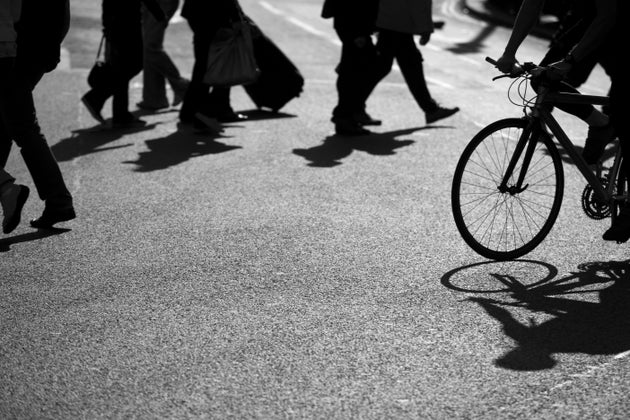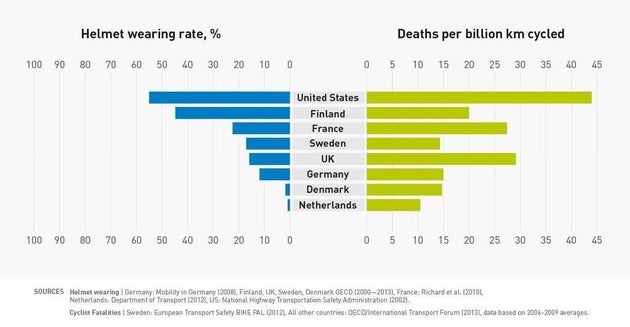
It happens with incredible predictability, and it never fails to create a discussion, which is exactly why it continues to happen with incredible predictability. Each time a professional racing cyclist enters the public limelight, fresh from becoming a national hero and enjoying the novelty of newfound mainstream media attention, they’re asked the question it’s assumed that all cyclists should know the answer to: “Should helmets be made compulsory?”
This time it was recent Tour de France winner and all-round-nice-guy Geraint Thomas, who after a throwaway line during an interview in The Sunday Times found himself at the centre of a debate he confessed afterwards to knowing very little about.
The resulting opinions are treated with undue gravitas. No-one asks Sir Mo Farah what he thinks about pedestrian crossings, it occurred to me on Sunday. Or indeed ask Lewis Hamilton on road safety, as someone else suggested.
Helmets should be about personal choice otherwise there may be unintended negative consequences for cycling uptake, and consequently, public health. I mostly wear a helmet, dependent on the environment I’m in, and my kids always wear a helmet. But I’d much rather position cycling as a normal and beneficial activity, rather than putting focus on a statistically small outcome of injury. By reducing the barriers to start cycling, we stand a chance of tackling nearly 90,000 deaths per year, which come as a result of physical inactivity-related disease.
So why shouldn’t we listen to professional cyclists? As Twitter and article comments show, helmet compulsion is a contentious issue that can put some of Britain’s most-famous-but-least-qualified cyclists unwittingly at the centre of a debate they’d spent very little time thinking about.
Professional cyclists cumulatively spend thousands of hours turning the pedals, so you might argue they would be the perfect spokespeople for the topic; some of these miles are ridden in a manner that an amateur road cyclist could relate to, perhaps navigating the UK’s country roads on a Sunday morning. But many aren’t. Additionally, often pro cyclist’s experiences of cycling back home is patchy after spending season-after-season riding many of their training miles in places like the French Riviera, Mallorca or Girona, with very different terrain and culture towards cycling.
Most importantly, the experience of riding to develop world-class physical fitness is totally incomparable with what it’s like for normal folk to cycle in the UK’s towns and cities. What it’s like to cycle to the shops. To cycle to take your children to school. To cycle to work each day. To cycle because, in England, 56% of trips under five miles (DfT National Travel Survey 2017) were made by car and you’ve found that a bicycle is a great and low cost way to get around.
It’s in these towns and cities, including London and its hideous congestion, where there is most potential to encourage more to take to two wheels, improving the nation’s health, our collective quality of lives and reduce pollution, amongst a host of other benefits.
Cyclists like Geraint Thomas, Laura Kenny or Sir Bradley Wiggins get given, often against their wishes, a huge platform post-Tour de France or Olympics success. Thomas later said he’d given no thought to his comments. “It’s nothing I’ve ever thought about,” he says. “Didn’t realise people felt so passionately about helmets!”
They do. And unfortunately for Thomas it had an unintended impact on the national debate of the subject, creating a distraction from discussing the dangers people face while cycling in Britain.
There is a big difference in choosing to wear a helmet and helmet compulsion. On any side of the argument there is huge emotion. In descending a Pyrenean mountain during the Tour de France at 70 km/h, it’s probably wise to wear a helmet. There are also countless anecdotes of people whose lives, they are told by medical professionals, were saved by a helmet taking the brunt of the impact in a crash. Helmets, whilst only lab-tested during low speed collisions, could quite possibly save you from injury. So if you feel you should wear one, you should wear one.
And no-one is arguing against the right to wear a helmet if you wish to. The risk with the recent comments on compulsion is that the discussion becomes about helmets being the key to keeping cyclists safe, when in reality, helmets are not even in the top ten things that keep cycling safe, as Chris Boardman eloquently states.
If we treat anecdotes as a way to form policy – which many believe may happen with the government’s recent consultation on proposed new cycling offences – then cycling’s uptake is likely only going to decrease. The consultation on creating a law for causing death or serious injury when cycling stemmed from the tragic but isolated death of Kim Briggs, and the high-profile campaign which ensued, led by her widower.
If we ignore statistics and create public policy based on headlines, then when you look at the bigger picture, more people could be killed than are saved through unnecessary cycling legislation.
If we put it into a different context, it seems quite mad. Take the story of a five-a-side footballer, whose legs were saved from amputation after a car crash because he was still wearing shin-pads. “’If it hadn’t been for the pads the pedals would have gone straight through the bones,” said the driver. No sane minded person is going to argue passionately for compulsory shin pads – or body armour – for motorists, because the statistical likelihood of being injured in this way is so low.
And the same should apply for cycling. Cycling is statistically safer than walking and yet the public discussion and media noise would make you think otherwise. This, in turn, stops people from giving it a try.
In countries where helmets are compulsory, such as Australia, cycling levels have decreased; cycling in Perth – and indeed bicycle sales – were reduced by around 30%. In countries such as Denmark and the Netherlands, where there is proper cycling infrastructure and priority for cyclists and pedestrians, both the helmet wearing rate and deaths per billion km cycled are at their lowest.

It’s the kind of discourse about helmets we’ve experienced over the weekend which perpetuates the most unhelpful debates about cycling safety. For every national phone-in debate or breakfast sofa chat about helmet compulsion, we miss the opportunity to talk about how normalising cycling and building infrastructure that people feel safe using – with or without helmets – can make our nation healthier.
That’s why we should use data and the bigger picture, not pro cyclists, to shape the helmet compulsion debate.
Adam Tranter is a former racing cyclist and founder and of Fusion Media, a cycling-focused communications agency